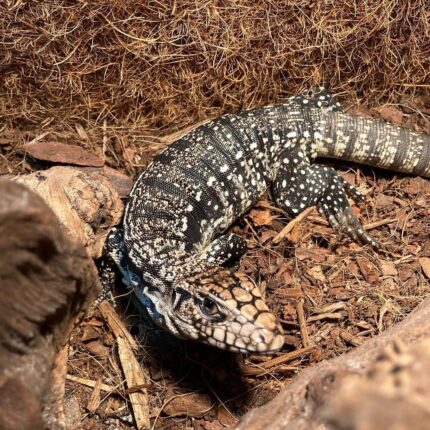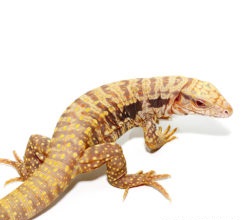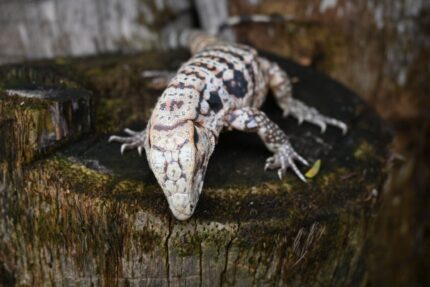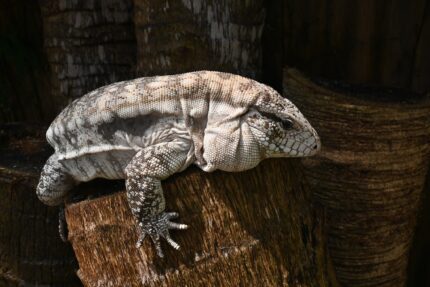Owning a red tegu is not a task for the faint of heart. These lizards get massive and require an enclosure not everyone can create. However, if you are an experienced reptile enthusiast and want to give it a whirl—find out all basics.
These lizards are actually quite docile and agreeable for their size. So, if you’ve dreamed of owning a giant reptile, this might be a good beginner for you. They do have long lifespans and specific care, so let’s make sure you’re up for the challenge.
Quick Facts about Red Tegus
| Species Name: | Tupinambis rufescens |
| Common Name: | Red Tegu |
| Care Level: | Intermediate |
| Lifespan: | 15-20 years |
| Adult Size: | 3-5 feet |
| Diet: | Omnivore |
| Minimum Tank Size: | Twice the length of their body |
| Temperature: | Daytime: 85-100 degrees F / Nighttime: 70 degrees F |
| Humidity: | 60-80% |
Do Red Tegus Make Good Pets?
Red tegus are native to parts of South America, including Argentina, Paraguay, and Bolivia. These tropical big guys love hot, humid weather—so no matter where you live in the world, they need heat
Red tegus can make good pets to the right owners. Because these lizards grow to such a large size, it’s important to fully grasp exactly how much room they need.
But don’t let their massive size necessarily deter you—these lizards are pretty docile creatures that require an intermediate amount of care.
Appearance
As you may guess by the name, red tegus come in a variety of red hues. But there is some variation between the sexes. Hatchlings tend to be dull in color, but they start to develop pigment around sexual maturity.
As male tegus age, they turn deep, dark red that is almost entirely solid. They grow to roughly 5 feet with sturdy, bulky bodies.
Females generally have more patterns on their scales than their male counterparts, which is an excellent way to decipher the sexes. Females grow to be slightly smaller than males, averaging roughly 4 feet as adults.
How to Take Care of Red Tegus
Creating a proper enclosure with all of the right elements is crucial for your tegu’s health and wellbeing. Let’s discuss all of the essentials.
Habitat, Tank Conditions & Setup
Creating the right kind of habitat for your red tegu is essential to their wellbeing. Here are the main components of your setup.
Tank
As juveniles, red tegus aren’t very big. However, they get big fast. Fully grown adults need an enclosure that is at least twice the length of its body. Since males can grow up to 5 feet, you have to be ready to accommodate their adult size.
Most people choose to have an entire room or outdoor enclosure dedicated to their tegu friends. They do very well in shed enclosures, permitting they have an adequate amount of heat and humidity. Also, they need to be totally safe from even slight drafts.
Lighting
For optimal health, red tegus require UVB lighting to soak in nutrients from the rays into their skin. They need at least 12 to 14 hours of UVB light daily, followed by regular dark nights.
Heating (Temperature & Humidity)
Red tegus need to have several temperatures available so that they can regulate their body temperatures.
They need a consistent temperature in their enclosure between 75 and 85 degrees F with a basking spot of up to 100 degrees F.
They need the humidity to stay between 70% and 90%.
Substrate
Red tegus need a type of substrate that will retain moisture well. The best selections include soil and sand mixtures, cypress mulch, or coconut coir.
| Tank Recommendations | |
| Tank Type | Large indoor enclosure (premade or DIY) |
| Lighting | UVB light |
| Heating | Tank heating pad, ceramic heating element, red bulb lighting |
| Best Substrate | Coconut coir, cypress mulch, sand and coil combo
|
Feeding Your Red Tegu
Red tegus are voracious and opportunistic eaters. Because they are omnivores, they benefit from a variety of meat, fruits, and vegetables. Be careful—these lizards will eat anything they can fit into their mouth if it moves.
Like many other reptiles, these creatures needed added calcium in their diet to promote adequate bone health and growth. You will have to buy a calcium supplement and give them the proper dosage according to the product label.
Juvenile tegus will crave mostly meats since they need the extra protein during their growth period. They will thrive on a diet of mostly dubia roaches and earthworms. When your tegu reaches adulthood, they need a few more greens in their diet. However, you will have to up the protein portions. You can feed adult red tegus mice, chicks, eggs, and fish. You can still offer large insects, too.
| Diet Summary | |
| Fruits & Veggies | 10% of diet |
| Insects | 65% of diet |
| Meat | 25% of diet – mice, chicks, eggs |
| Supplements Required | Calcium
|
Keeping Your Red Tegu Healthy
Before you ever bring your red tegu home, it’s important to find an exotic vet in your area if you don’t already have one. These lizards require special care outside of the expertise or regular animal clinics.
You might not need to see a vet often, but immediate vet care is paramount if your lizard develops a sudden illness or problem. Many times, lizards don’t show signs of sickness until it’s quite advanced.
Common Health Issues
Red tegus can encounter several health concerns, but most commonly, you might see:
-
Calcium & phosphorus deficiency
-
Salmonella
-
Internal & external parasites
Lifespan
If you have a healthy lizard with no preexisting health conditions, you can expect them to live between 15 and 20 years.
Breeding
In the wild, red tegus begin to breed right after brumation ceases. So, around March they will begin the natural cycles of reproduction. At this time, males will actively seek out females for roughly two weeks.
Females are incredibly protective of their nest of eggs. Once she lays, you must stay away and keep all other tegus from bothering her. She will be highly territorial and can do some real damage.
In one clutch, the successful outcome of the eggs is about 50%. Females usually lay about 30 eggs per clutch. Eggs incubate roughly 60 days before hatching, as long as all conditions are right.
Are Red Tegus Friendly? Our Handling Advice
One thing that makes red tegus so desirable is that they are docile and easy to be around. There is rarely any aggression being cage mates, either.
These lizards do get large—and they weigh up to 15 pounds. You will always have to be extra cautious when you handle it. One drop can severely injure your bulky guy. Tegus are friendly enough that they might even come up to you for scratches and snacks.
Always remember to wash your hands thoroughly after handling, as they can carry potentially harmful bacteria, like salmonella.
Shedding & Brumation: What to Expect
Unlike some other reptiles, red tegus shed in sections rather than all at once. When you see scales raising and turning pale in spots, it means that portion of their skin is ready to shed.
When you notice that they are starting to shed, it’s important to keep them very moist to make the process easier. Rather than intervening, allow shedding to occur naturally. Picking off the skin flakes could cause irritation or even infection.
Red tegus typically enter brumation between the colder months—roughly October to March. They will be sluggish, slow, and more inactive during this time.













Reviews
There are no reviews yet.